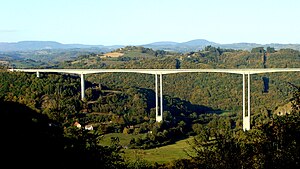Pays de Tulle
The Pays de Tulle is a traditional French landscape in the heart of the Corrèze department . It is located in historic Limousin and is part of the Nouvelle-Aquitaine region .
geography
The Pays de Tulle, the German landscape of Tulle , surrounds the name-giving city of Tulle , seat of the prefecture of the Corrèze department.
It is surrounded by the following natural spaces:
- the Montagne limousine with the Massif des Monédières in the north
- the Dordogne limousine to the east
- the Xaintrie in the southeast
- the Briver Basin in the southwest
- the Pays d'Uzerche in the west.
In terms of administration, the Pays de Tulle essentially extends over the 45 municipalities of the Tulle Agglo municipal association .
Hydrography
The Pays de Tulle is drained roughly in the middle by the Corrèze , which drains to the southwest and flows into the Vézère in the Briver basin as a left tributary . In the extreme southeast, the Dordogne is just touched, which also drains in the southwest.
geology

Geologically, the Pays de Tulle belongs entirely to the crystalline basement of the western Massif Central . Upcoming are gneisses , mica slate , granitoids , amphibolites and rare eclogites . The north-northwest trending Argentat Fault - a significant cataclastic fracture zone several kilometers wide - divides the region into two terranos. In the east there is the approximately north-south trending parautochthonous bulge of the Plateau de Millevaches with its mica schists and granitoids - but this is only touched at the edge. The lion's share in the west consists of rocks from the upper and lower gneiss cover . The former has slipped from the lower gneiss cover and contains quartz diorite intrusions . The lower gneiss cover appears in the core area in a south-east-north-west trending anticline structure - the Tulle anticline . This connects to the south of the Uzerche Synclinory . The Cornil granodiorite penetrated into their saddle area made of leptynites (former rhyolites ) and Cambrian migmatitic orthogneiss 317 million years ago ( Bashkirian ) .
The right-shifting and southeast-trending Estivaux Fault then separates the entire amphibolite facial terran in the far west from the green slate facial Thiviers-Payzac unit . Further south, with fault contact or by means of discordance, the Upper Carboniferous and Permomesozoic of the Briver Basin join.
literature
- Frédéric Zégierman: Le Guide des Pays de France, Sud . Fayard, 1999.
Individual evidence
- ↑ Bernard-Griffiths, J. and Vachette, M .: Age Cambrien des migmatites de l'anticlinal de Tulle (Massif Central Franqais) et ses relations avec l'âge du granite dit "tardimigmatitique" de type Cornil . In: CR Acad. Sci. Ser. 2, 270, 1970, pp. 916-919 .
